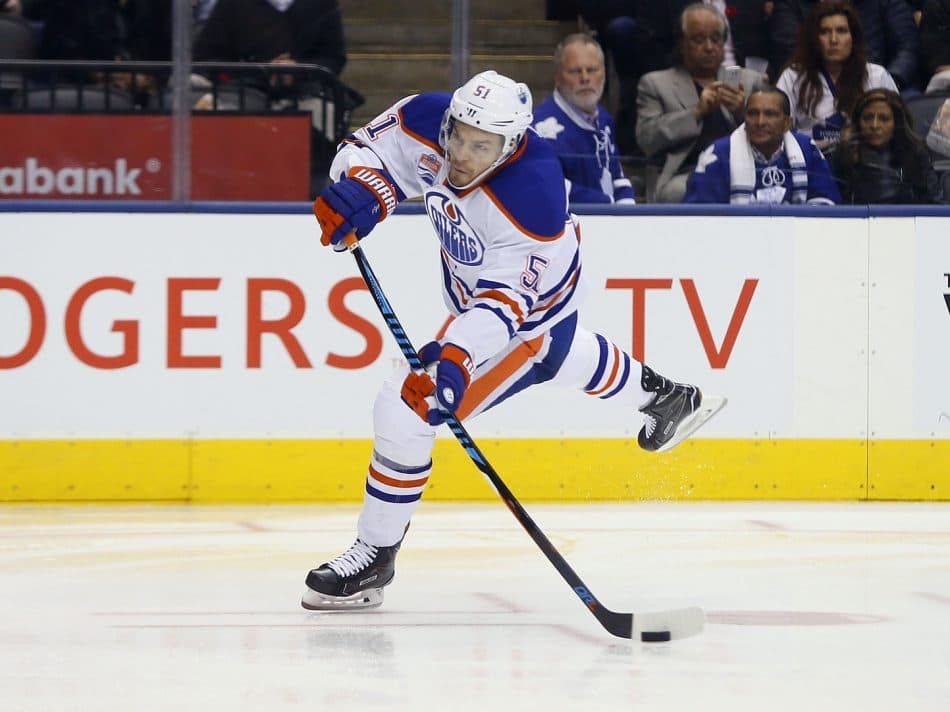2016-17 Edmonton Oilers: No. 51 C Anton Lander
In the end, Anton Lander played 215 games for the Edmonton Oilers, which is a solid return on the club’s investment of the 40th overall pick back in 2009. It’s still difficult not to think of his time with the team in terms of unmet potential.
The first thing I ever read on Lander was in The Hockey News, which had him ranked as the 50th-best option in his draft year. In six paragraphs, that publication included two quotes from unnamed scouts, and those quotes still stand up nearly a decade later.
- Scout No. 1: “He’s the captain of Sweden for a reason – high, high character. He gets results through hard work and character.”
- Scout No. 2: “He’s not a real good skater and he’s not very big or explosive on his skates, but I think he’ll compensate for that with his hockey sense.”
Those two quotes capture Lander even today. He’s an intelligent player, an incredibly hard-working professional and the kind of guy a coach wants in the room. He’s also undersized and an unremarkable skater. If those are the cases for and against, the tiebreaker surely comes down to his offensive game, something which he proved maddeningly incapable of translating from the AHL to NHL.
It’s probable that the decision on Lander was made not in 2016-17, but a full year beforehand.
Let’s rewind.
In 2014-15, Todd Nelson was brought in at midseason as Edmonton’s interim coach. The Oilers were badly deficient at centre, and his promotion coincided with a similar one for Lander, who to that point had been stuck in the minors. Lander delivered brilliantly, including in a significant role on the revitalized power play, scoring 20 points in 38 games. That’s almost 60 percent of his career offence in the majors in less than 20 percent of his career games.
The circumstances were ideal for Lander, playing for his long-time AHL coach and being placed in a position to excel. He earned a two-year extension as a result. The good times didn’t last, though. The next season he’d be playing for yet another new NHL coach, Todd McLellan. Things went badly.
Defensively, Lander had his uses. He won 55 percent of his faceoffs. He spent 1:56/game on the penalty kill. He started an incredibly high percentage of his shifts in the defensive zone, almost sawing off on the shot clock and keeping goals against totals low.
Unfortunately, he delivered nothing offensively. Edmonton averaged less than a goal/hour at 5-on-5 when he was on the ice, a brutally low number. Lander scored a single goal and just three points in 61 games, despite even getting a look on the power play.
McLellan gave Lander a lot of rope in 2015-16, and understandably decided not to do the same thing in 2016-17. The funny thing is that Lander’s results were really quite good, though it wasn’t enough to move him back into the coach’s plans.
Consider: More than half of Lander’s shifts this year started in the defensive zone. That’s not to say he started about the same amount of time in the offensive and defensive ends of the rink; rather, he started more faceoffs in the defensive zone than in the offensive and neutral zones combined.
Edmonton did really well, considering. They broke even with the opposition by both goal and shot metrics with Lander on the ice, an outstanding achievement for the line (with Mark Letestu and a rotating right wing) given its usage. Lander only managed four points in 22 games, but he did it in less than three hours of total 5-on-5 ice-time, meaning he even had a strong scoring rate for a depth player.
Just for good measure, Lander delivered his usual high performance on the penalty kill and in the faceoff circle (56.0% win rate).
It didn’t matter. Lander’s long struggle to fill the net at the NHL level, culminating in a brutal one goal-in-61 games performance in 2015-16 had established him as too weak an offensive performer in the minds of the coaching staff. It’s a defensible position; Lander had plenty of chances over the years and couldn’t get the job done. His strong work in a short stint in 2016-17 was arguably not enough to overturn such a substantial prior.
Now, Lander’s bound for Europe, perhaps permanently. I expect he’ll perform well in the KHL, and he may even get a shot at the Swedish Olympic team in 2018 if the NHL skips the event. If the right situation presents itself – in Lander’s shoes, even a league-minimum NHL contract probably makes sense if Nelson finds an NHL coaching position – maybe he’ll come back. If it doesn’t, he should have a lot of value in any other hockey league on the planet.
As far as Edmonton is concerned, one imagines this is all she wrote. Lander was a brilliant AHL player for the organization in every conceivable way, and there was never any reason to fault his work ethic in the majors. If the offence had developed, he would have been a fine third-line centre, but one strong half-season in six years just wasn’t enough.
Bottom line: Lander was an excellent depth player for the Oilers in 2016-17, but a fresh start for player and organization alike made sense this summer given the long and mostly fruitless history between them.
Previous year-end reviews:
- Centre: Leon Draisaitl, Drake Caggiula, David Desharnais
- Left Wing: Milan Lucic, Patrick Maroon, Matt Hendricks
- Right Wing: Jordan Eberle, Zack Kassian, Tyler Pitlick, Iiro Pakarinen
- Left Defence: Andrej Sekera, Darnell Nurse, Griffin Reinhart
- Right Defence: Adam Larsson, Kris Russell, Mark Fayne
- Goal: Cam Talbot, Laurent Brossoit

